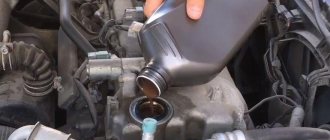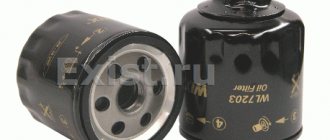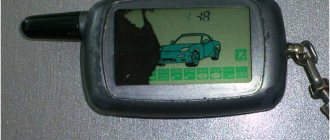24.08.2020
| (Votes: 1, Rating: 5) |
Issues discussed in the material:
- Where and how can you change the oil in a car?
- Procedure for a standard oil change at a service station
- Advantages and disadvantages of express engine oil change at a service station
- Oil change cost
- What car owners say about choosing where and how to change the oil
Where can I change the oil? An eternal question, with the answer to which hundreds of advisers come running to you and everyone praises their choice. Essentially, there are three places where you can change the oil in a car’s engine or transmission: a service station (with variations on the theme), a garage technician, or in your garage/yard.
The choice depends solely on your desire to save time and money. If you change the oil yourself, be prepared to get dirty, and also keep in mind that the likelihood of an error increases in inverse proportion to your skill as an auto mechanic. Replacing at a service station virtually eliminates failures and saves you time in exchange for a small service fee.
Where and how can you change the oil in a car?
Where can you change the oil and how to do it correctly? There are many ways, below we will consider the pros and cons of each of them. We will also look at which method is recommended depending on the car model, and which one is better not to use at all.
- If you simply remove the lubricant through the drain hole, approximately 10% of the used fluid will remain in the engine. Therefore, this easy and inexpensive method is not effective enough.
- You can also add a flushing agent to the internal combustion engine, but then the cost of replacement will increase, while a small amount of flushing will remain in the engine, as a result of which the properties of the new lubricant will change for the worse.
- If you fill in the flushing agent 150–200 km before the planned lubricant change, then driving the car will not be safe. During this time, it is necessary to operate the car with caution, since flushing is not intended for increased loads. In addition, you will be forced to visit the service station again.
- You can flush the internal combustion engine by pouring special oil into it to clean the engine, but the liquid will not be completely drained. Experts consider this method to be the most preferable, since the used flushing lubricant will not change the properties of the new oil.
- If the engine is not new and is very dirty, the lubricant will have to be changed twice: first of all, new lubricant is poured in, after 200–300 km of quiet driving it is drained. After this you need to add new oil. This method is quite expensive, but it allows you to keep the internal combustion engine in working condition.
- The old grease can be pumped out through the neck of the dipstick, but in this case it will not be possible to completely remove the waste fluid. Oil will remain on horizontal surfaces, in channels, between the pump and filter. If you choose this replacement method, it is not necessary to lift the car, install a new drain plug, or remove the underbody protection. But this is only the case when the oil filter can be removed and unscrewed from above.
- Not long ago, a new method was invented to replace the lubricant. First you need to do pneumatic cleaning and fill the internal combustion engine with new oil. Of course, it will not be possible to remove 100% of the waste fluid, but this method is suitable if a non-separable oil filter is installed on the car.
It is not recommended to use the methods described above (all except the first) if the car is new and the lubricant recommended by the manufacturer was poured into the internal combustion engine. The use of half-measures, such as five minutes, is justified only in order to calm yourself down. If you purchased a used car, you should completely flush the engine or drain and refill the lubricant twice.
How to profitably exchange a used car
To guarantee the legality of the used car exchange service and its objective cost, the purchase and sale process should be carried out at a trusted auto center. Here the client will be offered:
- Diagnostics of the old model, on the basis of which its cost will be determined;
- Selection of cars for exchange, completely new or with a clean mileage history: all cars undergo forensic examination, therefore the car dealership will never sell a car with a “dark past”;
- Legal support of the transaction: the client enters into a notarized agreement and, if necessary, can use the credit services of the car dealership’s partner bank;
- Efficiency of the service: the client does not need to look for buyers for his vehicle; he does not need to settle issues with the traffic police or the bank. The listed functions are the task of the auto center.
Read here! Rating and test of the best manufacturers of 2021 (145 photos and videos)
Thus, with minimal documents, it is possible to buy an improved car within one to three days. The used car exchange service makes it possible to regularly change the owner’s vehicle fleet by purchasing its best models.
Procedure for a standard oil change at a service station
If you don't know where you can change the engine oil on a lift, you should go to a service center. Everyone knows that before draining the used fluid, you should warm up the internal combustion engine to the required temperature, turn it off, and only then unscrew the oil filter and replace the lubricant.
At the service station, the car will be raised to such a height that it is convenient for the technician to work. First, the mechanic removes the engine protection. After this, using a wrench, unscrew the drain plug; through the hole, the waste liquid will flow into the container intended for draining.
Note!
Auto repair shops do not use equipment that pumps out lubricant through the dipstick hole. This replacement method has shown low efficiency, since in this case the liquid is not completely removed from the internal combustion engine.
If you have decided where you can change your engine oil, be prepared for the fact that this event will take about 15 minutes. An experienced mechanic, while under the car, will also inspect the car's brake system, chassis and suspension to identify any existing damage.
When all the old oil has drained, the technician will tighten the plug and then lower the lift along with your car.
The mechanic performs all other actions for changing the oil while working in the engine compartment. Namely, it will replace the oil filter, which after a run of 20,000 km completely becomes unusable, of course, if the car was operated under normal conditions.
If you do not replace the filter element, the new oil, passing through the bypass valve, will immediately become contaminated, and dirt particles will fall on the rubbing elements of the engine.
As a result, the internal combustion engine will quickly fail, as all its parts will wear out. If this happens, the emergency pressure lamp will not work, and the motorist will not be able to understand what kind of breakdown has occurred.
Before installing the oil filter, the technician will fill it 50% with lubricant and also apply it to the rubber band located on the filter element housing. After this, the mechanic will pour engine oil into the internal combustion engine in an amount of 80% of the required volume.
We recommend
“What kind of oil to pour into the engine: standards, recommendations, opinions” Read more
Then he will carefully add lubricant to the required level, so that the oil boundary is between the max and min marks on the dipstick. To control the volume of fluid being poured, a car mechanic uses an oil dipstick.
When choosing a car service where you can change the oil in a gearbox or engine, you should trust this work only to trusted technicians. The fact is that if the mechanic fills in more lubricant than required, an “oil burn” will begin. Otherwise, the internal combustion engine will starve of oil, as a result the engine will quickly wear out. That is why the master must focus on the marks in order to fill in the required amount of engine oil.
Once the replacement is complete, the mechanic will reset the service intervals. This procedure must be performed if the car is equipped with on-board electronics that determine the time for the next engine oil change.
Filling the gearbox with oil
Filling the engine with oil is relatively easy, and every driver can do it. Another question: where to fill the gearbox oil? Here, the constructive varieties are so wide that an exact answer cannot be obtained without knowing the specific model. The common thing is that the hole is located at the bottom of the car; it must be placed on a pit or a lift. There are rare opportunities when the filler hole can be reached from the engine compartment, but this is rare. The car must be in a horizontal plane.
Checking the oil level in the gearbox
Basically, the transmission filler hole is located in the front of the transmission housing, or slightly to the side. Not always, the gearbox is equipped with a dipstick for measuring the level; its replacement is your own finger. You unscrew the nut (often, the arrow on it shows the direction), if a trickle of oil flows from the transmission, then everything is fine with the amount of oil, if it does not flow, stick your finger in. The level should be at the bottom edge of the hole; if it is less, then you need to top it up.
You will have to pour oil into the gearbox using a funnel, syringe (non-medical) or vacuum devices. Filling occurs before excess oil begins to flow out of the gearbox. At the end of the procedure, the nut is screwed tightly.
Advantages and disadvantages of express engine oil change at a service station
If your time is limited, you can perform an express lubricant change. Even if you trust auto mechanics, it’s still worth checking how well the work is done.
When choosing a service center where you can change the oil in an automatic transmission or engine, inspect the equipment used for repair work.
It is important that specialists use not a standard stand-alone device with a hand pump, but professional equipment with adapters and an electric compressor. Using such a system, you can change the lubricant on any internal combustion engine, so the engine oil change will be done efficiently.
In addition, look at the amount of lubricant that was pumped out; the differences from the total volume should be no more than 150–200 g, which may remain on the surfaces of the motor.
When deciding on the choice of a car repair shop where you can change the oil in your car, study all the offers. The fact is that at many service stations, express replacement is carried out free of charge if you buy lubricant from this organization. Preference should be given to well-known large car service centers if you want the lubricant change to be done correctly and high-quality oil to be poured into the internal combustion engine.
Compared to the standard replacement procedure, express replacement of lubricant is carried out through the dipstick hole in the following order:
- First, the engine must be warmed up to the required temperature so that the lubricant becomes liquid and easily flows into the crankcase.
- After this, you need to take out the dipstick and insert a small diameter tube into the hole.
- When one end of the tube is at the bottom of the crankcase, the mechanic will connect it to the tank.
- A pressure difference is created in the container using a compressor or hand pump. As a result, the waste liquid is pumped out through the tube.
- After the oil has been drained, the technician will remove the tube and install the dipstick back.
- Then he will replace the filter element and add new lubricant.
Advantages of hardware oil change. Motorists leave both positive and negative reviews about hardware lubrication:
- Thanks to express replacement, it is possible to pump out about 95% of the waste liquid. This result can be obtained if you completely disassemble the internal combustion engine and blot the parts with a cloth.
- A hardware replacement is suitable if your machine has a faulty drain plug or a broken pan, as it will not require any impact on these elements.
- It will be possible to drain the old oil even if it is not possible to install the car on a lift or overpass. In addition, the replacement procedure can be carried out without using a drain key.
- Express replacement is an ideal solution when you are in a hurry and need to replace the lubricant urgently.
- Many service stations offer to change the lubricant for free if you buy engine oil from them.
Now let's talk about the disadvantages of vacuum engine oil change.
Each method of changing engine oil has its pros and cons; there is no ideal option that is suitable for every car. Express replacement also has its drawbacks, but they are few. The most significant of them is that by removing used lubricant using this method, it will not be possible to remove particles of dust and metal, dirt, carbon deposits from the bottom of the pan, as well as heavy compounds.
Another disadvantage of express replacement: the car owner will not have the opportunity to simultaneously inspect the sump, chassis, brake system, suspension, front axle, cooling system fan in order to eliminate possible damage. The fact is that if this method of draining old oil is used, the car will not be driven onto an overpass or lift. Therefore, if you need to carry out a technical inspection of the car, you will have to reserve time.
It is important not only to choose the right place to change the oil, but also to decide on the replacement method. In any case, the owner of the car must decide. Do not think that express replacement is preferable to the standard lubricant change procedure.
It is always worth considering the specifics of each individual situation. Professionals recommend using a new method for changing engine oil each time. This approach will eliminate the occurrence of negative consequences.
Briefly about the essence of the procedure
I don’t see any point in describing in detail what express replacement is and how it is performed using certain devices of different professional levels.
Do-it-yourself plastic bumper repair: video instructions
Category: DIY repairs
I will try to briefly describe what a quick replacement is, how it differs and why this service is so often used by, let me say, lazy car owners who do not have the time or desire to fully remove old used motor oil. This is, of course, easier when at least 10 points work next to me. To be honest, I once thought about express replacement as a business idea. But soon he quickly said goodbye to her. This is an illiquid service that costs 300-500 rubles. Earnings come from others. Moreover, you will learn about this in the section about the disadvantages of this method.
Well, let's take a look at the essence of express replacement. The liquid in the form of old motor oil does not drain through a special hole, which is provided on the bottom of the crankcase on all machines.
A different approach is used for draining. Namely through the dipstick. In fact, the oil is not drained, but rather sucked out of the engine. First, the probe is simply removed and a tube is inserted into the hole formed. At the other end of this tube there is a pump and a container in which all the sucked liquid is collected. If the tube reaches the bottom of the engine crankcase, there are no particular complaints about the hardware replacement, since under such conditions it is possible to efficiently remove the old oil sediment. But the design of many engines does not allow for express replacement to reach the place where dangerous mining deposits accumulate.
The method looks quite interesting and promising. After all, it turns out that the car does not need to be lifted with a lift, on an overpass or climbed under it, which requires an additional inspection hole. The tube from the oil suction apparatus is inserted into the hole of the dipstick and the lubricant is removed using special equipment. Then all that remains is to change the old oil filter, fill in new oil such as Liqui Moly, and that’s it, the car is ready for further use. The manipulations are extremely fast and simple, which explains the name of the express replacement.
But this only at first glance seems so convenient and promising. In fact, despite the obvious advantages, a quick oil change also has its serious disadvantages. We'll talk about the pros and cons separately.
Main advantages
I’ll slightly whet your interest in the most important part of the article, and first I’ll suggest you look at the strengths of express engine oil change in a car engine.
The strengths of draining waste through the dipstick are as follows:
How does the ERA GLONASS button work on a car and why is it needed at all?
Category: Instructions
- Low price for services provided. Using the express method to pump out oil is not only quick, but also quite cheap. Although there may be additional costs involved;
- Save time. Despite the need to visit a service station where the appropriate equipment is available, draining and changing the fluid takes a minimum of time;
- No need to crawl under the car. Simply lift the hood, remove the dipstick, and pumping begins. Filling is done traditionally through the filler hole;
- The oil does not spill anywhere, does not spill onto your clothes or onto the floor;
- A professional method that involves the participation of experienced specialists in the process;
- There is no need to get rid of working off yourself.
That's all with the advantages. If you know any other strengths, write in the comments.
Key Disadvantages
I would like to remind you that express replacement also has other names. This is a vacuum and hardware replacement. But the name doesn’t change the essence.
Now it is important to focus on what disadvantages this method has and what the danger is.
One of the disadvantages is the difficulty of performing an express replacement with your own hands. Self-pumping is possible, but for this you will have to buy a special device costing about 10-15 thousand rubles minimum. For an ordinary car owner, these are completely meaningless, unjustified costs.
But I want to focus on the main drawback. Since pumping is carried out through the hole in the dipstick, the tube does not reach the bottom of the engine crankcase. What does this mean? It's simple. It is at the bottom that sediment, waste, particles of metal shavings and all those components settle that, when circulating through the lubrication system, cause damage to the engine. It is because of this sediment that it is extremely important to change the engine oil on time, otherwise rapid wear of parts simply cannot be avoided. Repeated replacement using exclusively the express method leads to the fact that the amount of sediment and metal shavings, along with other components of used oil, grows rapidly. And this is a direct threat to the integrity of the engine. You can find many visual videos online that demonstrate the consequences of incorrect oil changes.
No, express replacement has a right to exist. But only with the right approach. Experts advise alternating a quick replacement with a complete one, when all the fluid is drained, up to removing the oil pan and mechanically removing all contaminants. After serious cleaning, it is possible to change the oil using the hardware method as part of the next maintenance. But then you need to completely drain the waste through the drain hole again. At approximately every 2-3 scheduled replacement, it is a good idea to flush the engine. For this purpose, special flushing oils are used, which you can learn more about in the material at the link.
In addition to the underlying danger, there is also a risk of encountering unscrupulous service station employees. They begin to look for non-existent problems, drop oil on the engine unnoticed by you, focusing attention on the fact that your oil seals are leaking or other problems have arisen in the oil system. Plus, the expensive oil you bought can be replaced with a cheap one. There are many tricks and tricks.
We recommend: Urea for diesel: what is it and what is it for?
You can draw the final conclusions yourself. Share your opinion in the comments and leave feedback. Thanks everyone for your attention!
Thanks for reading! Please rate the article
( 1 ratings, average: 5.00 out of 5)
Loading…
Oil change cost
How much you spend on a replacement is determined by the region in which you live. In big cities, the cost of this procedure is higher than in a small town.
If you live in the capital, be prepared to spend about 1 thousand rubles. to replace the lubricant. In the provinces, the cost of this procedure is low. For example, the average cost of replacing engine oil will be 200 rubles. On average in Russia, you will have to pay 450–500 rubles for this work.
Note! The price for lubricant replacement will be higher if you want:
- install new oil filters;
- flush the system.
The cost of motor oil also plays an important role.
If you need to change the oil in the gearbox, the situation will be slightly different. Most motorists who drive a car with an automatic transmission believe that they don’t have to change the lubricant at all. This opinion is wrong.
Any oil, even transmission oil, loses its properties after a certain mileage. The cost of changing automatic transmission oil may vary depending on the price of the lubricant. Mineral oils have the lowest price, but such lubricants quickly lose their properties. Synthetics are more expensive, but they don’t need to be changed often.
The lubricant consumption depends on the volume of the automatic transmission crankcase. For example, on many Russian cars the crankcase is five-liter, but on foreign cars the volume can reach ten liters. For example, this amount of gear oil will be required for a jeep.
We recommend
“How much engine oil is needed to change: let’s look at the volume and timing” Read more
How often do you need to change the lubricant? To answer this question, you need to consider the following factors:
- how intensively the car is used;
- what climate do you live in?
- vehicle model.
Be prepared to change the lubricant every 40 thousand kilometers if you live outside the city. In city driving conditions, this period can be increased by 2.5 times.
The cost of replacing the lubricant is also determined by the pricing policy of the service station. Therefore, before choosing a place where you can change the oil, check out the price list of the nearest car service centers. In addition, to be sure of the quality of repair work, study customer reviews of the selected service center.
Universal tips for changing oil: on your own or at a service station
It doesn’t matter where you are going to change the oil: in a small car service center or a dealership, follow the following recommendations so that the lubricant change is carried out correctly and your car works properly.
- Choose the right lubricant . Engine oil must meet tolerances; it is better to choose the lubricant recommended by the car manufacturer. When purchasing, pay attention not only to the thickness of the oil.
- Do not perform express replacements too often . In this case, a fairly large amount of old oil will remain in the engine, so it is better to choose the standard replacement procedure, when the used fluid is completely drained. Alternate these two methods, reducing the replacement interval.
- The more often you drain the old oil, the better . Even the most expensive oil filter is not able to protect against microparticles of dust and dirt. But the fuel filter cannot cope with the impurities contained in the fuel.
- Do not use popular engine oil additives or additives . Remember that the additives wear off quickly.
- Check the lubricant level periodically using the dipstick . If its quantity is insufficient, the internal combustion engine will starve of oil, as a result of which the engine will wear out. The lubricant level should not exceed the maximum mark, since in this case the motor will also not work properly.
- Buy oils only from trusted stores . If the lubricant turns out to be counterfeit, its properties will not meet the requirements of the car manufacturer, and as a result, the internal combustion engine will fail. Original products can be purchased at branded gas stations or in a car store that sells high-quality oils. Choose lubricant in metal cans.
To change the lubricant in a car, you should do the following:
- Place your car with a warm engine in a garage pit or on an overpass, if you have one. Next, simply open the hood and remove the neck from the engine drain hole.
- At the same time, place an empty container under this neck, then manually unscrew the drain cap.
- When everything goes out, carefully pour new clean oil into it and turn on the engine. Also, don’t forget to fill the engine with oil through the filler neck. What to do next? Just turn the cap and screw it back to its original position - back.
- At the end of the procedure, all you have to do is turn on your car and check that the pressure level warning light has stopped lighting.
- I also hope it will not be a discovery for you if the lamp does not light up when you turn on the engine for the first time. Typically, the system needs about 20 seconds for the motor to develop the pressure necessary for its operation.











